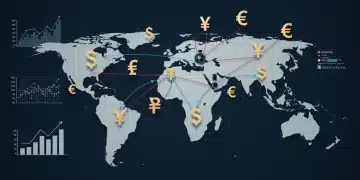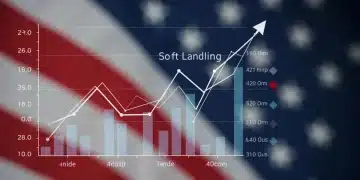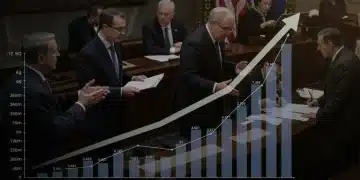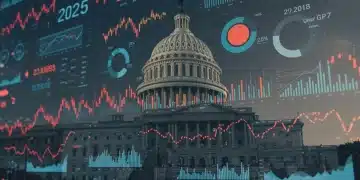COVID-19’s Long-Term Economic Effects on US: An Analysis

The COVID-19 pandemic profoundly altered the United States economy, triggering shifts in labor markets, supply chains, and consumer behavior that continue to influence fiscal and monetary policies.
As the initial shockwaves of the COVID-19 pandemic recede, a critical question emerges: what are the enduring economic shifts shaping the United States? This article delves into the multifaceted and profound ways the crisis has reshaped our financial landscape, offering an in-depth look at the COVID-19 economic effects and their persistent imprint on the nation’s future.
Labor market transformation and the ‘great reshuffling’
The COVID-19 pandemic triggered an unprecedented upheaval in the United States labor market, forcing millions out of work almost overnight and fundamentally altering the relationship between employees and employers. This period, often dubbed the ‘Great Reshuffling,’ saw significant shifts in workforce participation, industry demands, and worker expectations.
Initially, industries like hospitality, retail, and travel experienced severe job losses. However, sectors such as e-commerce, logistics, and technology saw rapid expansion, creating new opportunities. This divergence underscored the uneven impact of the pandemic across different segments of the economy.
Shifting worker priorities
One of the most notable long-term effects has been a re-evaluation of work-life balance and job satisfaction among employees. Many workers, empowered by remote work options and a tight labor market, began demanding more flexibility, better benefits, and higher wages.
- Increased demand for remote or hybrid work arrangements.
- Greater focus on mental health and well-being benefits.
- Higher expectations for wage growth and career development.
- Reluctance to return to low-wage, high-contact service jobs.
This shift has placed pressure on businesses to adapt their employment strategies, leading to innovations in recruitment, retention, and workplace culture. Companies that fail to meet these evolving expectations risk losing talent in an increasingly competitive environment.
The pandemic also exacerbated existing labor shortages in critical sectors, including healthcare and education, while simultaneously accelerating automation trends in others. The long-term implications include a potential restructuring of the workforce, with a greater emphasis on skills training and adaptability to new technologies. Understanding these dynamics is crucial for grasping the full scope of COVID-19 economic effects.
Inflationary pressures and monetary policy responses
A defining characteristic of the post-pandemic economic landscape has been the surge in inflation, reaching levels not seen in decades. This phenomenon is a complex interplay of demand-side pressures, supply-side constraints, and geopolitical factors, all exacerbated by the initial pandemic response.
Massive fiscal stimulus packages, designed to cushion the economic blow of lockdowns and support households, injected significant purchasing power into the economy. Coupled with accommodative monetary policy, including low interest rates and quantitative easing, this fueled robust consumer demand for goods.
Supply chain disruptions and their role
At the same time, global supply chains, already operating with lean inventories, were severely disrupted by factory shutdowns, port congestion, and labor shortages. This mismatch between strong demand and constrained supply created upward pressure on prices across a wide range of goods and services.
- Production delays due to factory closures and labor absenteeism.
- Logistical bottlenecks at ports and transportation hubs.
- Increased shipping costs and raw material prices.
- Geopolitical events, like the war in Ukraine, further disrupting energy and food markets.
In response to persistent inflation, the Federal Reserve embarked on an aggressive campaign of interest rate hikes, aiming to cool demand and bring prices under control. This tightening of monetary policy has significant implications for borrowing costs, investment, and economic growth, shaping the trajectory of the COVID-19 economic effects for years to come. The delicate balance between taming inflation and avoiding a recession remains a central challenge for policymakers.
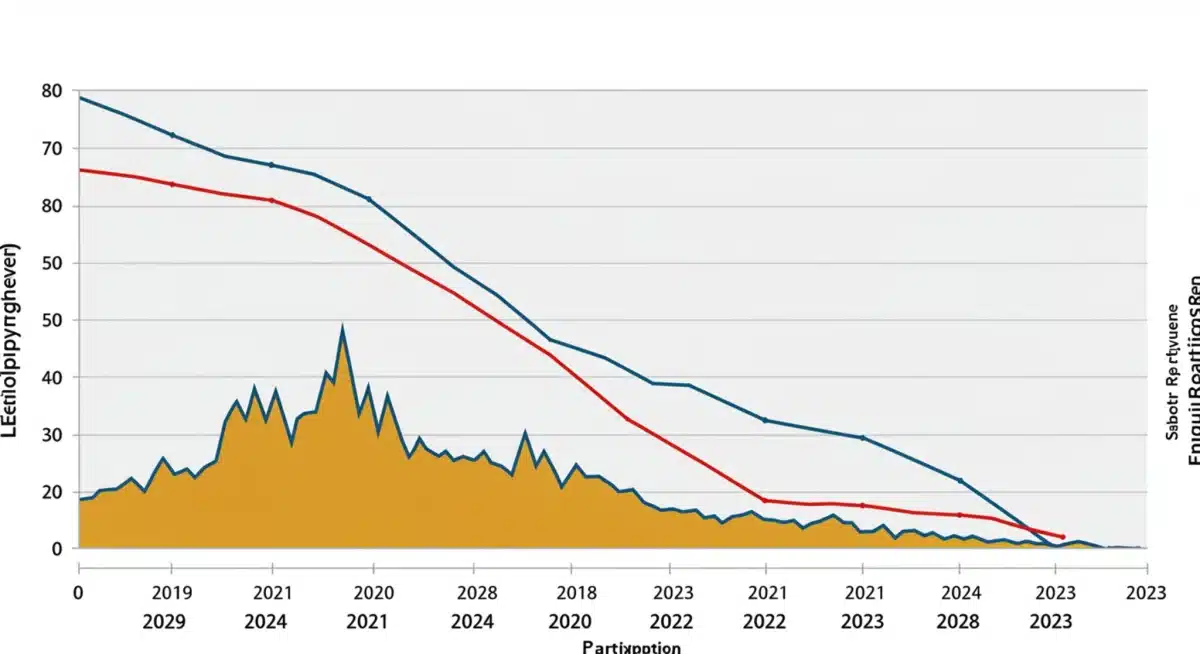
Impact on consumer behavior and household finances
The pandemic fundamentally reshaped how Americans spend, save, and manage their finances. Faced with uncertainty, lockdowns, and unprecedented government support, households adapted in ways that continue to influence economic trends. Initially, there was a dramatic shift from services to goods consumption, as opportunities for travel, dining out, and entertainment were severely curtailed.
This surge in goods demand contributed significantly to supply chain pressures and inflation. Simultaneously, many households accumulated substantial savings, thanks to stimulus checks, enhanced unemployment benefits, and reduced spending opportunities. This ‘excess savings’ provided a buffer for some, but also fueled later spending sprees.
Long-term changes in spending habits
While some pre-pandemic spending patterns have returned, others appear to have changed permanently. E-commerce adoption accelerated dramatically, becoming a standard for many more consumers. There’s also a heightened awareness of financial vulnerability, leading some to prioritize saving and debt reduction.
- Sustained preference for online shopping and digital services.
- Increased focus on health, wellness, and home-related spending.
- Greater demand for flexible payment options and contactless transactions.
- Potential for a more cautious approach to discretionary spending among certain demographics.
The pandemic also exposed and exacerbated wealth disparities. While some households thrived, others struggled with job loss, health crises, and mounting debt. The long-term challenge involves addressing these inequalities and ensuring that the economic recovery benefits all segments of the population. Understanding these shifts in consumer behavior is vital for businesses and policymakers navigating the ongoing COVID-19 economic effects.
Supply chain resilience and global trade reconfigurations
The fragility of global supply chains became glaringly apparent during the pandemic, as lockdowns, labor shortages, and unprecedented demand shifts led to widespread disruptions. These vulnerabilities forced businesses and governments to rethink their strategies for sourcing, production, and distribution, initiating a period of significant reconfiguration.
Initial responses focused on immediate crisis management, but the long-term trend points towards greater resilience and diversification. Companies are exploring options like ‘friend-shoring’ or ‘near-shoring’ to reduce reliance on distant or politically sensitive regions, aiming to shorten supply lines and increase control over production processes.
Strategies for enhanced resilience
Businesses are investing in technology and data analytics to gain better visibility into their supply chains, enabling them to anticipate and mitigate future disruptions more effectively. This includes adopting AI for demand forecasting and implementing IoT devices for real-time tracking of goods.
- Diversification of suppliers across multiple geographies.
- Increased domestic production and manufacturing capabilities.
- Investment in automation and advanced logistics technologies.
- Building larger inventory buffers for critical components and materials.
Government policies are also playing a role, with initiatives aimed at strengthening domestic manufacturing and securing critical supplies, particularly in sectors like semiconductors and pharmaceuticals. While a complete reversal of globalization is unlikely, the emphasis has definitively shifted towards more robust and less vulnerable supply networks. These adjustments are a direct consequence of the COVID-19 economic effects on global trade dynamics.
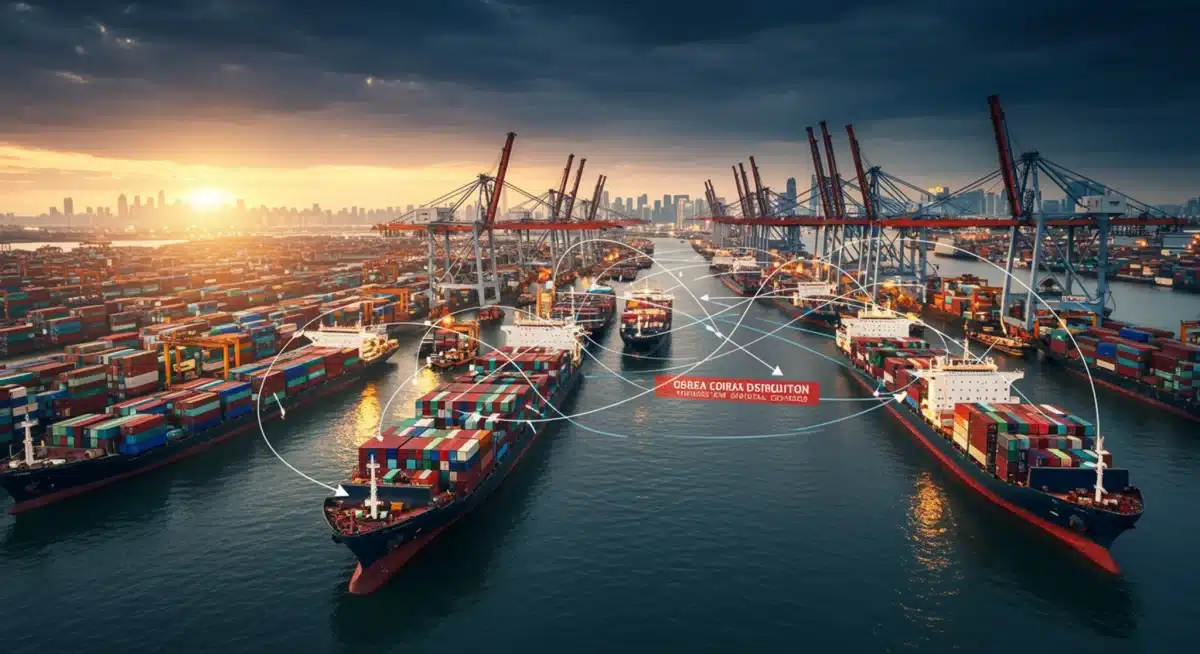
Technological acceleration and digital transformation
The COVID-19 pandemic acted as a powerful catalyst for technological acceleration and digital transformation across nearly every sector of the United States economy. What might have taken years to implement happened in mere months, as businesses and consumers rapidly adopted new digital tools to navigate lockdowns and maintain connectivity.
Remote work became the norm for millions, driving massive investments in cloud computing, video conferencing, and cybersecurity infrastructure. E-commerce, already growing, saw exponential expansion, forcing even traditional brick-and-mortar businesses to establish robust online presences.
Emergence of new business models
Beyond remote work and e-commerce, the pandemic spurred innovation in areas like telehealth, online education, and automation. Businesses discovered new efficiencies and opportunities by leveraging digital platforms, leading to the emergence of novel business models and service offerings.
- Rapid adoption of telehealth services, transforming healthcare delivery.
- Expansion of online learning platforms and remote education tools.
- Increased investment in automation and AI to mitigate labor shortages.
- Growth of the gig economy and flexible work arrangements facilitated by digital platforms.
This accelerated digital transformation has long-term implications for productivity, competitiveness, and the future of work. It demands continuous upskilling and reskilling of the workforce to adapt to evolving technological landscapes. The digital economy, profoundly shaped by the COVID-19 economic effects, is now an undeniable force driving growth and change.
Government debt, fiscal policy, and future economic stability
The unprecedented fiscal response to the COVID-19 pandemic led to a significant increase in government debt in the United States. Trillions of dollars were allocated to direct aid for individuals, businesses, and state and local governments, aimed at preventing a deeper economic collapse.
While these measures were largely successful in averting a severe depression, they also contributed to a substantial expansion of the national debt. The long-term implications of this increased debt burden are a subject of ongoing debate among economists and policymakers, touching upon issues of intergenerational equity, future fiscal flexibility, and potential inflationary pressures.
Challenges for future fiscal policy
Managing this elevated debt level will require careful consideration of future fiscal policy choices. Options include strategies for revenue generation, spending prioritization, and economic growth initiatives that can increase the tax base. The balance between stimulating growth and ensuring fiscal sustainability is delicate.
- Potential for higher interest rates to increase debt servicing costs.
- Constraints on future government spending for other priorities.
- Debates over tax policy and entitlement reform to address long-term solvency.
- Importance of sustained economic growth to help reduce the debt-to-GDP ratio.
The pandemic has underscored the vital role of government intervention during times of crisis, but it has also highlighted the need for sustainable fiscal frameworks. The ability of the United States to navigate these fiscal challenges will be a critical determinant of its long-term economic stability and its capacity to respond to future shocks, marking another significant facet of the COVID-19 economic effects.
Resilience and adaptation of small businesses
Small businesses, the backbone of the American economy, faced immense challenges during the COVID-19 pandemic. Lockdowns, reduced consumer traffic, and supply chain disruptions threatened their very existence. However, their response also showcased remarkable resilience and adaptability, leading to significant changes in their operational models and market strategies.
Many pivoted quickly, shifting to online sales, offering curbside pickup, or completely redesigning their service delivery. Government aid programs, such as the Paycheck Protection Program (PPP), provided crucial lifelines, helping many stay afloat during the most severe periods of economic contraction.
Innovations in business models
The crisis accelerated the adoption of digital tools and e-commerce capabilities among small businesses, many of whom had previously relied solely on physical storefronts. This digital transformation has opened new markets and enhanced operational efficiencies.
- Rapid adoption of e-commerce platforms and digital marketing.
- Increased flexibility in staffing and operational hours.
- Greater emphasis on local sourcing and community engagement.
- Innovation in product and service offerings to meet changing consumer needs.
While many small businesses struggled and some unfortunately closed, those that adapted successfully emerged stronger, more agile, and better equipped for future disruptions. The pandemic has fundamentally altered the competitive landscape for small businesses, emphasizing the importance of innovation and digital integration for long-term survival and growth. Their ongoing evolution is a testament to the diverse and complex COVID-19 economic effects.
| Key Economic Aspect | Brief Description of Impact |
|---|---|
| Labor Market | Shifted worker priorities, increased remote work, and exacerbated labor shortages in key sectors. |
| Inflation | Fueled by fiscal stimulus and severe supply chain disruptions, leading to aggressive monetary tightening. |
| Supply Chains | Exposed vulnerabilities, prompting diversification, near-shoring, and increased resilience efforts. |
| Digital Transformation | Accelerated adoption of digital tools, e-commerce, and remote work across all economic sectors. |
Frequently asked questions about COVID-19’s economic impact
The pandemic led to a ‘Great Reshuffling,’ with increased demand for remote work, higher wages, and better work-life balance. It also exacerbated labor shortages in sectors like healthcare and accelerated automation, fundamentally altering employment dynamics.
Inflation was primarily driven by a combination of strong consumer demand fueled by fiscal stimulus and severe, widespread supply chain disruptions. Geopolitical events also contributed to rising energy and food prices.
Yes, the pandemic significantly accelerated e-commerce adoption and shifted spending from services to goods. While some pre-pandemic patterns returned, a sustained preference for online shopping and a heightened focus on financial security remain.
The pandemic exposed critical vulnerabilities in global supply chains, leading to widespread disruptions. This prompted businesses to pursue diversification, near-shoring, and increased investment in resilience and technological solutions for logistics.
The substantial government spending increased national debt significantly. Long-term implications include challenges for fiscal flexibility, potential for higher debt servicing costs, and ongoing debates about sustainable revenue generation and spending priorities.
Conclusion
The COVID-19 economic effects on the United States are profound and multifaceted, reshaping fundamental aspects of the nation’s economy. From a transformed labor market characterized by shifting worker priorities and accelerated automation to persistent inflationary pressures stemming from supply-demand imbalances, the pandemic has left an indelible mark. It forced businesses to reconfigure supply chains for greater resilience, spurred an unprecedented acceleration in digital transformation, and significantly expanded government debt, posing complex fiscal challenges for the future. Understanding these enduring shifts is crucial for policymakers, businesses, and individuals alike as the U.S. economy continues to adapt and evolve in a post-pandemic world, striving for sustainable growth and stability amidst ongoing global uncertainties.
